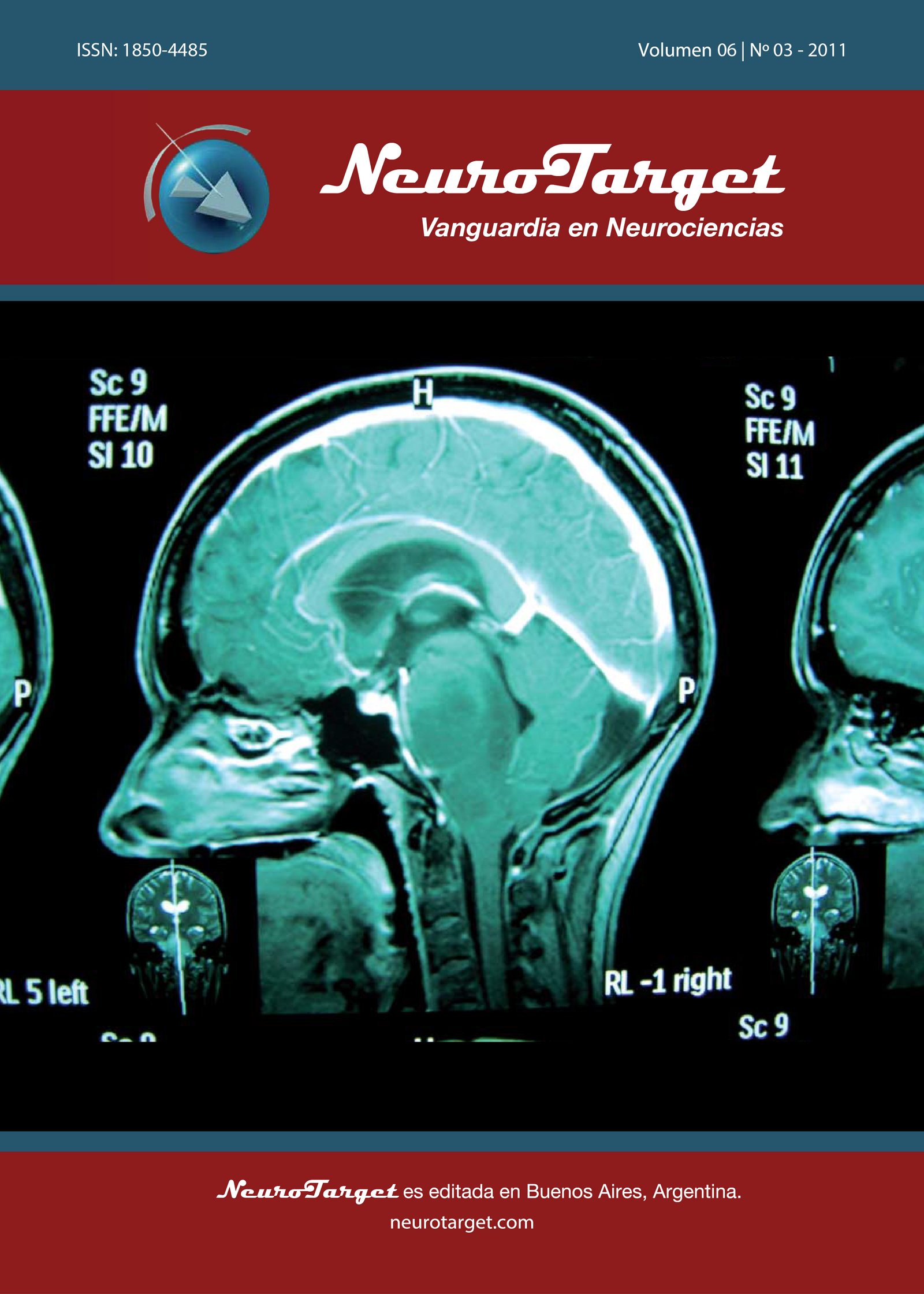Efecto analgésico de los antagonistas del receptor histamínico H en el modelo de dolor inducido por formalina en ratas
Publicado originalmente en la Revista Dor, São Paulo, 2011 Jul-set;12(3):240-4.
DOI:
https://doi.org/10.47924/neurotarget2011282Palabras clave:
cimetidina, Dolor, formalina, loxtidina, ranitidina, ratasResumen
Racinal y Objetivos: Los Antagonistas de los receptores de histamina presentan efectos sobre el dolor. Los Antagonistas del receptor de histamina H presentan efecto analgésico local, y el papel de los antagonistas del receptor H sobre el dolor en el sistema nervoso periférico todavía no está aclarado. Este estudio tiene por objetivo evaluar los efectos de diferentes antagonistas H sobre el dolor inducido por la administración de formalina en extremidades de ratas.
Método: se estudiaron ratas machos divididos en grupos a los que se inyectó formalina en una extremidad y paralelamente diferentes antagonistas del receptor ranitidina, cimetidina y loxtidina, en diferentes concentraciones (0,05 μmol, 0,25 μmol ou 1 μmol). Fue evaluado el número de elevaciones de la extremidad inyectada durante un período de 45 minutos.
Resultados: La loxtidina inhibió el número de elevaciones de la extremidad inyectada en las dos fases del test a partir de las tres concentraciones utilizadas, la ranitidina disminuyó el número de elevaciones de la pata a partir de la concentración de 0,25 μmol en la fase II. La cimetidina no inhibió ese comportamiento doloroso.
Conclusión: De acuerdo con los resultados de este estudio, algunos antagonistas del receptor H presentan un efecto analgésico local, que parece ser fármaco específico y no de clase farmacológica específica.
Métricas
Citas
Raffa RB. Antihistamines as analgesics. J Clin Pharm Ther 2001;26(1):81-5.
Ash AS, Schild HO. Receptors mediating some actions of histamine. Br J Pharmacol Chemother 1966;27(2):427-39.
Soll AH, Walsh JH. Regulation of gastric acid secretion. Annu Rev Physiol 1979;41(1):35-53.
Schwartz JC, Arrang JM, Garbarg M, et al. Histaminergic transmission in the mammalian brain. Physiol Rev 1991;71(1)1-51.
Oda T, Morikawa N, Saito Y, et al. Molecular cloning and characterization of a novel type of histamine receptor preferentially expressed in leukocytes. J Biol Chem 2000;275(47):36781-6.
Hofstra CL, Desai PJ, Thurmond RL, et al. Histamine H receptor mediates chemotaxis and calcium mobilization of mast cells. J Pharmacol Exp Ther 2003;305(3):1212-21.
Chung YH, Miyake H, Kamei C, et al. Analgesic effect of histamine induced by intracerebral injection into mice. Agents Actions 1984;15(3- 4):137-42.
Malmberg-Aiello P, Lamberti C, Ghelardini C, et al. Role of histamine in rodent antinociception. Br J Pharmacol 1994;111(4):1269-79.
Brown RE, Stevens DR, Haas HL. The physiology of brain histamine. Progr Neurobiol 2001;63(6):637-72.
Galeotti N, Malmberg-Aiello P, Bartolini A, et al. H1-receptor stimulation induces hyperalgesia through activation of the phospholipase C-PKC pathway. Neuropharmacology 2004;47(2):295-303.
Thoburn KK, Hough LB, Nalwalk JW, et al. Histamine-induced modulation of nociceptive responses. Pain 1994;58(1):29-37.
Abacioglu N, Bediz A, Çakici I, et al. Antinociceptive effects of H1 and H2 antihistaminics in mice. Gen Pharmacol 1993;24(5):1173-6.
Passani MB, Lin JS, Hancock A, et al. The histamine H receptor as a novel therapeutic target for cognitive and sleep disorders. Trends Pharmacol Sci 2004;25(12):618-25.
Parada CA, Tambeli CH, Cunha FQ, et al. The major role of peripheral release of histamine and 5-hydroxytryptamine in formalin-induced nociception. Neuroscience 2001;102(4):937-44.
Ashmawi HA, Chambergo FS, Araújo Palmeira CC, et al. Effects of pyrilamine and cimetidine on mRNA c-fosexpression and nociceptive flinching behavior in rats. Anesth Analg 2003;97(2):541-6.
Shibata M, Ohkubo T, Takahashi H, et al. Modified formalin test: characteristic biphasic pain response. Pain 1989,38(3):347-52.
Zimmermann M. Ethical guidelines for investigations of experimental pain in conscious animals. Pain 1983;16(2):109-10.
Ashmawi HA, Braun LM, Sousa AM, et al. Analgesic effects of H1 receptor antagonists in the rat model of formalin-induced pain. Rev Bras Anestesiol 2009;59(4):461-70.
Wheeler-Aceto H, Cowan A. Standardization of the rat paw formalin test for the evaluation of analgesics. Psychopharmacology 1991;104(1):35-44.
Doak GJ, Sawynok J. Formalin-induced nociceptive behavior and edema: involvement of multiple peripheral 5-hydroxitryptamine receptor subtypes. Neuroscience 1997;80(3):939-49.
Dubuisson D, Dennis SG. The formalin test: a quantitative study of the analgesic effects of morphine, meperidine, and brain stem stimulation in rats and cats. Pain 1977;4(2):161-74.
Tjølsen A, Berge OG, Hunskaar S, et al. The formalin test: an evaluation of the method. Pain 1992;51(1):5-17.
Sousa AM, Franco PA, Ashmawi HA, et al. Local effect of tramadol on formalin evoked flinching behavior in rats. Rev Bras Anestesiol 2008;58(4):371-9.
Taylor BK, Peterson MA, Basbaum AI. Persistent cardiovascular and behavioral nociceptive responses to subcutaneous formalin require peripheral nerve input. J Neurosci 1995;15(11):7575-84.
Teng CJ, Abbott FV. The formalin test: a dose-response analysis at three developmental stages. Pain 1998;76(3):337-47.
Malmberg-Aiello P, Lamberti C, Ipponi A, et al. Evidence of hypernociception induction following histamine H1 receptor activation in rodents. Life Sci 1998;63(6):463-76.
Thurmond RL, Desai PJ, Dunford PJ, et al. A potent and selective histamine H receptor antagonists with antinflammatory properties. J Pharmacol Exp Ther 2004;309(1):404-13.
Sakurada S, Watanabe H, Mizoguchi H, et al. Involvement of the histaminergic system in the nociceptin-induced pain-related behaviors in the mouse spinal cord. Pain 2004;112(1-2):171-82.
Coderre TJ, Vaccarino AL, Melzack R. Central nervous system plasticity in the tonic pain response to subcutaneous formalin injection. Brain Res 1990;535(1):155-8.
Hunskaar S, Hole K. The formalin test in mice: dissociation between inflammatory and non-inflammatory pain. Pain 1987;30(1):103-14.
Puig S, Sorkin LS. Formalin-evoked activity in identified primary afferent fibers: systemic lidocaine suppresses phase-2 activity. Pain 1996;64(2):345-55.
Rumore MM, Schlichting DA. Analgesic effects of antihistaminics. Life Sci 1985;36(5):403-16.
Descargas
Publicado
Cómo citar
Número
Sección
Licencia
Derechos de autor 2011 Fernanda Deutsch, Hazem Adel Ashmawi, Cláudia Carneiro De Araújo Palmeira, Irimar De Paula Posso

Esta obra está bajo una licencia internacional Creative Commons Atribución 4.0.
Este artículo se distribuye bajo la licencia Creative Commons Attribution 4.0 License. A menos que se indique lo contrario, el material publicado asociado se distribuye bajo la misma licencia.







